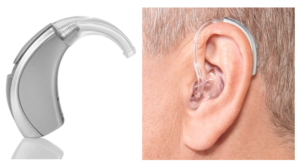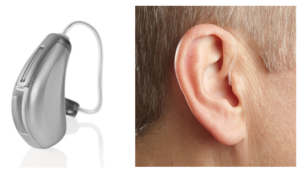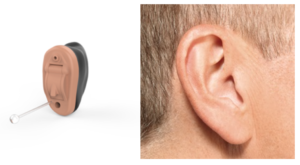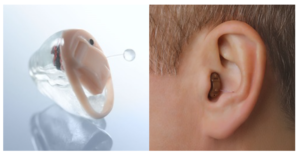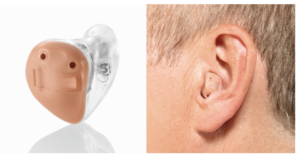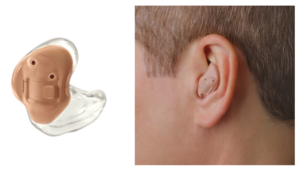BTE – Behind the Ear Hearing Aids
A BTE hearing aid behind the ear. The device has an ear hook from which a tube is attached. The tubing can be of different circumferences and thickness (depending on severity of loss) and attaches to an earpiece that fits in your ear. The earpiece could be a dome or a mould.
FOR – What’s good about BTE Behind the Ear hearing aids
- Due to larger size the hearing aid can have bigger controls which can help people with dexterity problems.
- The hearing aids can be very powerful to help people with severe to profound hearing losses.
- The hearing aid can fit a large battery for longer life.
- Some manufactures make a rechargeable version (no more changing batteries), ideal for users with dexterity or eyesight problems.
- The device will have room to fit in all the features of top of the range hearing aids:
- Can fit all components necessary for hearing aids to connect to devices e.g. phone, telecoil (loop) system
- Robust and durable.
AGAINST – Why you might not consider a Behind the Ear hearing aid
- BTE hearing aids are the biggest and therefore least discreet style.
- Tubing will become hard and stiff, needs changing every 6 months.
RIC – Receiver in Canal Hearing Aids
The most common hearing aid prescribed. Similar to a BTE but smaller. The receiver (speaker) sits in the ear canal. There is a wire (not tubing) that connects from the hearing aid to the speaker. The wire is very thin and therefore discrete. The earpiece could be a dome a micro mould depending on type of loss and dexterity capabilities of the user.
FOR – What’s good about Receiver in Canal Hearing Aids
- RIC hearing aids can very discrete look very stylish especially when compared to the plethora of new earbuds/headphones which are growing in popularity.
- Ideal for users who have high frequency hearing losses with normal or mild low frequencies. RIC’s can be configured with an open fit. This allows natural sounds to enter the ear canal as normal and gain is only given in the higher frequencies where there is hearing loss. Open fits avoid the occlusion effect, which is where the users own voice is amplified.
- RIC’s can be configured to cope with severe hearing aids.
- Can fit all components necessary for hearing aids to connect to devices e.g. phone, telecoil (loop) system.
- Robust and durable.
- All the main manufacturers make a rechargeable version (no more changing batteries), ideal for users with dexterity or eyesight problems.
AGAINST – Why you might not consider a Receiver in Canal hearing aid
- BTE hearing aids are the biggest and therefore least discreet style.
- Tubing will become hard and stiff, needs changing every 6 months.
IIC – Invisible In The Canal Hearing Aids
The most discrete hearing aid. Designed to sit deep in the ear canal. The hearing aid is usually custom made. A scan or impression is taken of the ear canal and the manufacturer will design and build a hearing aid to fit the user’s ear.
FOR – What’s good about IIC – Invisible In The Canal Hearing Aids
- IIC’s are the smallest and less visible type of hearing aid. Great for people with short hair or with hairstyles where the ears are visible and who are looking for an invisible hearing aid solution.
- Deep placement of the hearing aid can improve sound quality and may overcome occlusion effect.
AGAINST – Why you might not consider a IIC – Invisible In The Canal Hearing Aid
- IIC’s use the smallest batteries (size 10 yellow sticker). Though batteries are not particularly expensive (budget around £30 a year) the batteries need changing every few days. Tip – keep used batteries in a bag so you can easily take for recycling when full.
- Due to small size IIC’s cannot fit many controls (volume/program change). A remote control maybe available.
- At time of posting IIC hearing aids cannot fit technology to allow connectivity and streaming form mobile devices.
- If you have narrow or short ear canals the manufacturer may not be able to make the hearing aid as discrete as the user is expecting.
- Since the ear canal is a warm and moist environment IIC’s may generate a fault over their lifetime. Tip – ensure you get a long manufacturer’s warranty, ideally 5 years.
CIC – Completely In The Canal Hearing Aids
CIC’s were the smallest aids before IIC’s were released. Like IIC’s they are usually custom made for user.
FOR – What’s good about CIC – Completely In The Canal Hearing Aids
- Very small and discreet.
- Maybe able to connect to mobile phone. Resound recently launched a CIC hearing aid with this capability.
AGAINST – Why you might not consider a CIC – Completely In The Canal Hearing Aid
- CIC’s use the smallest batteries (size 10 yellow sticker). Though batteries are not particularly expensive (budget around £30 a year) the batteries need changing every few days. Tip – keep used batteries in a bag so you can easily take for recycling when full.
- Due to small size CIC’s cannot fit many controls (volume/program change). A remote control should be available.
- If you have narrow or short ear canals the manufacturer may not be able to make the hearing aid as discrete as the user is expecting.
- Since the ear canal is a warm and moist environment CIC’s may generate a fault over their lifetime. Tip – ensure you get a long manufacturer’s warranty, ideally 5 years.
ITC – In the Canal Hearing Aids
ITC hearing aids fit partially in the ear canal. They are usually custom made for the hearing aids user.
FOR – What’s good about ITC – In the Canal Hearing Aids
- Nothing behind the ear, some people find this an advantage, for example, if they wear glasses.
- Use a 312 battery (brown stickers) that may last up to 10 days. Tip – keep used batteries in a bag so you can easily take for recycling when full.
- if you have dexterity issues you may find an ITC one of the easier aids to insert.
- Can fit a volume control and program change function
- ITC’s have room to fit all the features of modern hearing aids including Bluetooth streaming to your mobile device.
Rechargeable versions are being launched as this is being written. Starkey and Phonak soon to release.
AGAINST – Why you might not consider an ITC – In the Canal Hearing Aid
- Can be more visible that a RIC hearing aid.
- Since the ear canal is a warm and moist environment ITC’s may generate a fault over their lifetime. Tip – ensure you get a long manufacturer’s warranty, ideally 5 years.
ITE – In the Ear Hearing Aids
In the ear hearing aids are the largest hearing aid usually custom made to fit in the ear.
FOR – What’s good about ITE – In the Ear Hearing Aids
- Nothing behind the ear, some people find this an advantage, for example, if they wear glasses.
- Use a 312 or 13 battery (brown or orange stickers) that may last up to two weeks with a 13 battery. Tip – keep used batteries in a bag so you can easily take for recycling when full.
- if you have dexterity issues you may find an ITE one of the easier aids to insert.
- Can fit a volume control and program change function.
- ITE’s have room to fit all the features of modern hearing aids including Bluetooth streaming to your mobile device.
Rechargeable versions are being launched as this is being written. Starkey and Phonak soon to release.
AGAINST – Why you might not consider an ITE – In the Ear Hearing Aid
- One of the more visible and therefore noticeable hearing aids.
Find out about our free at-home hearing tests. Once you know the problem, you can start working on the solution.

